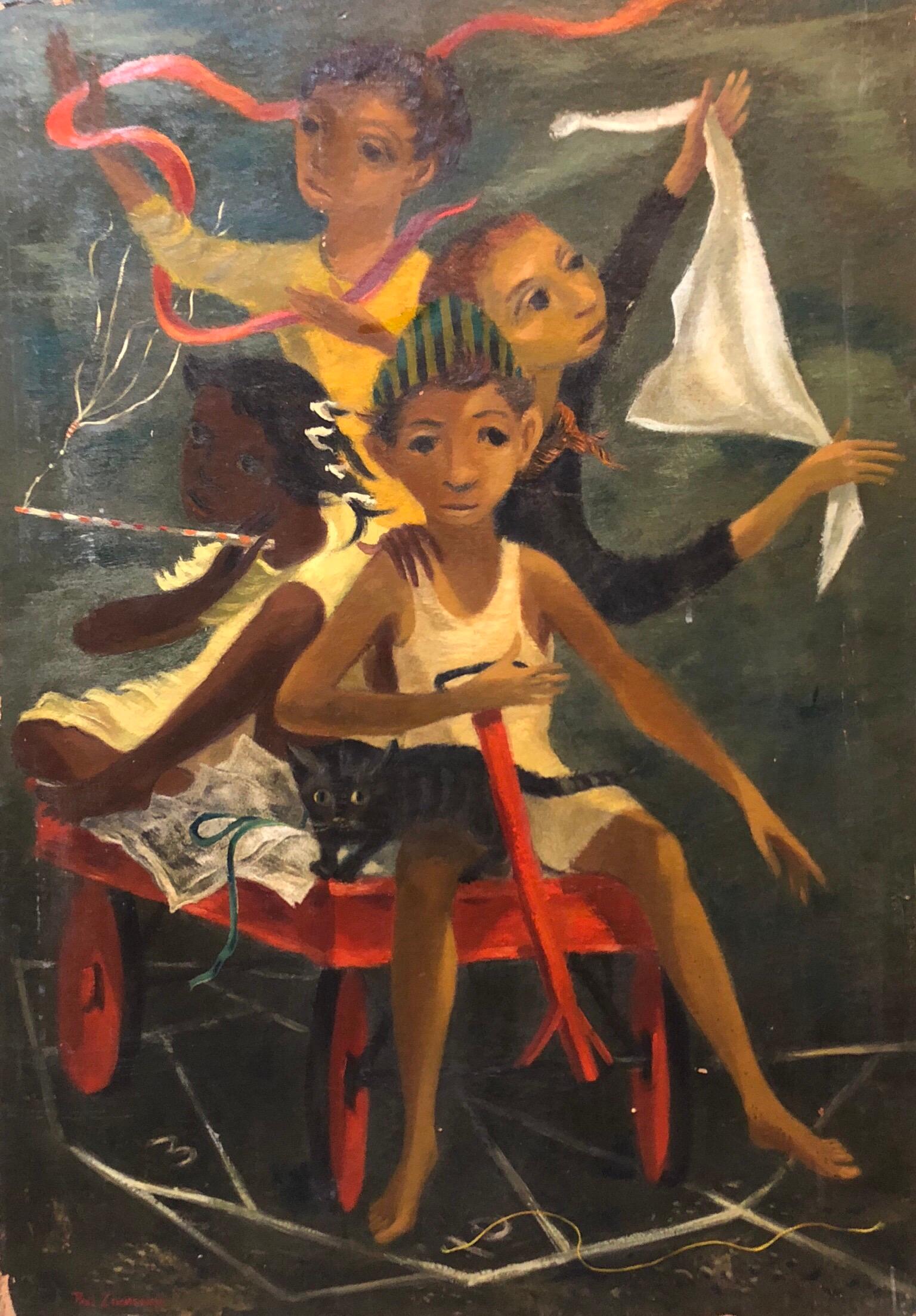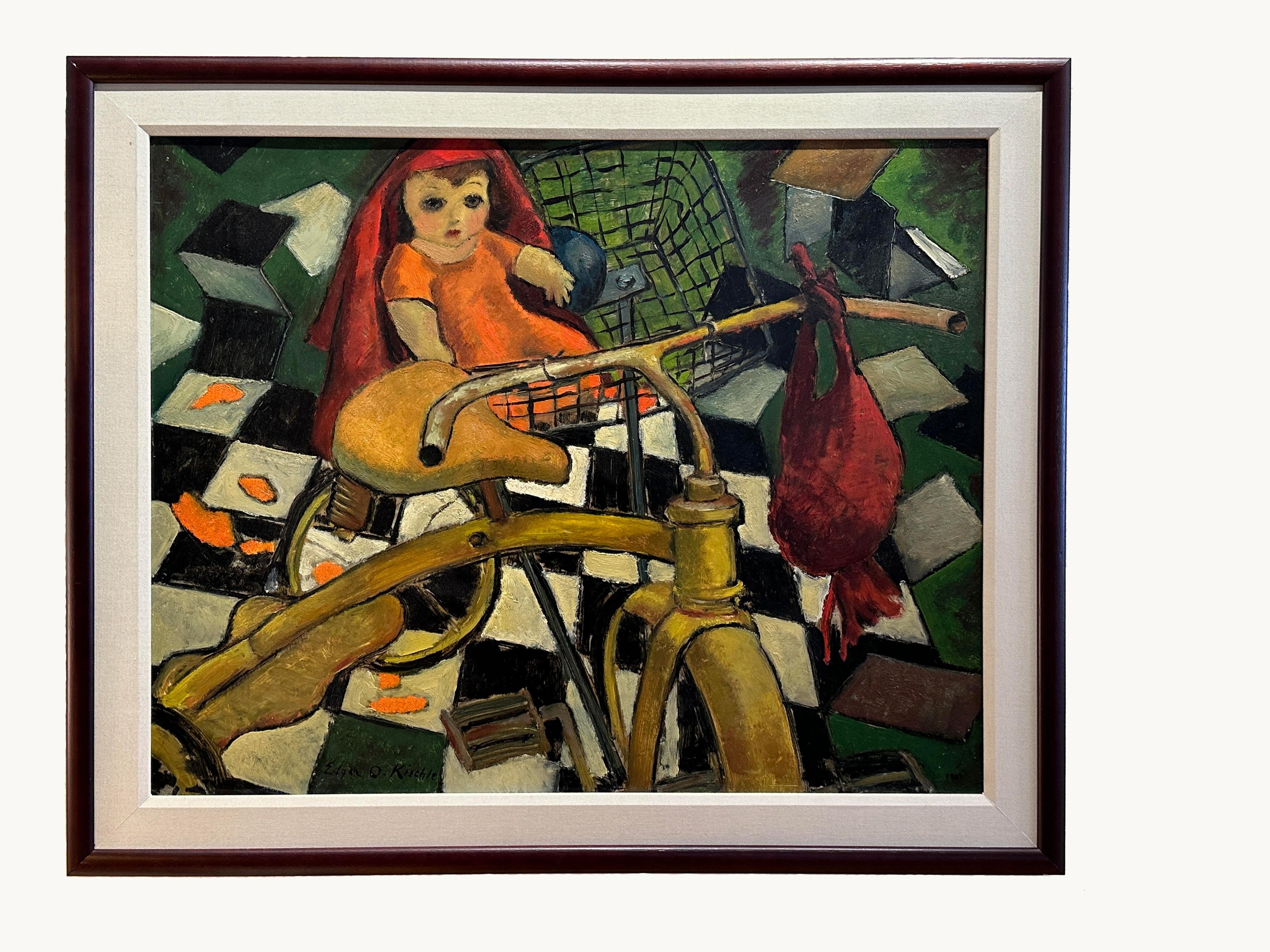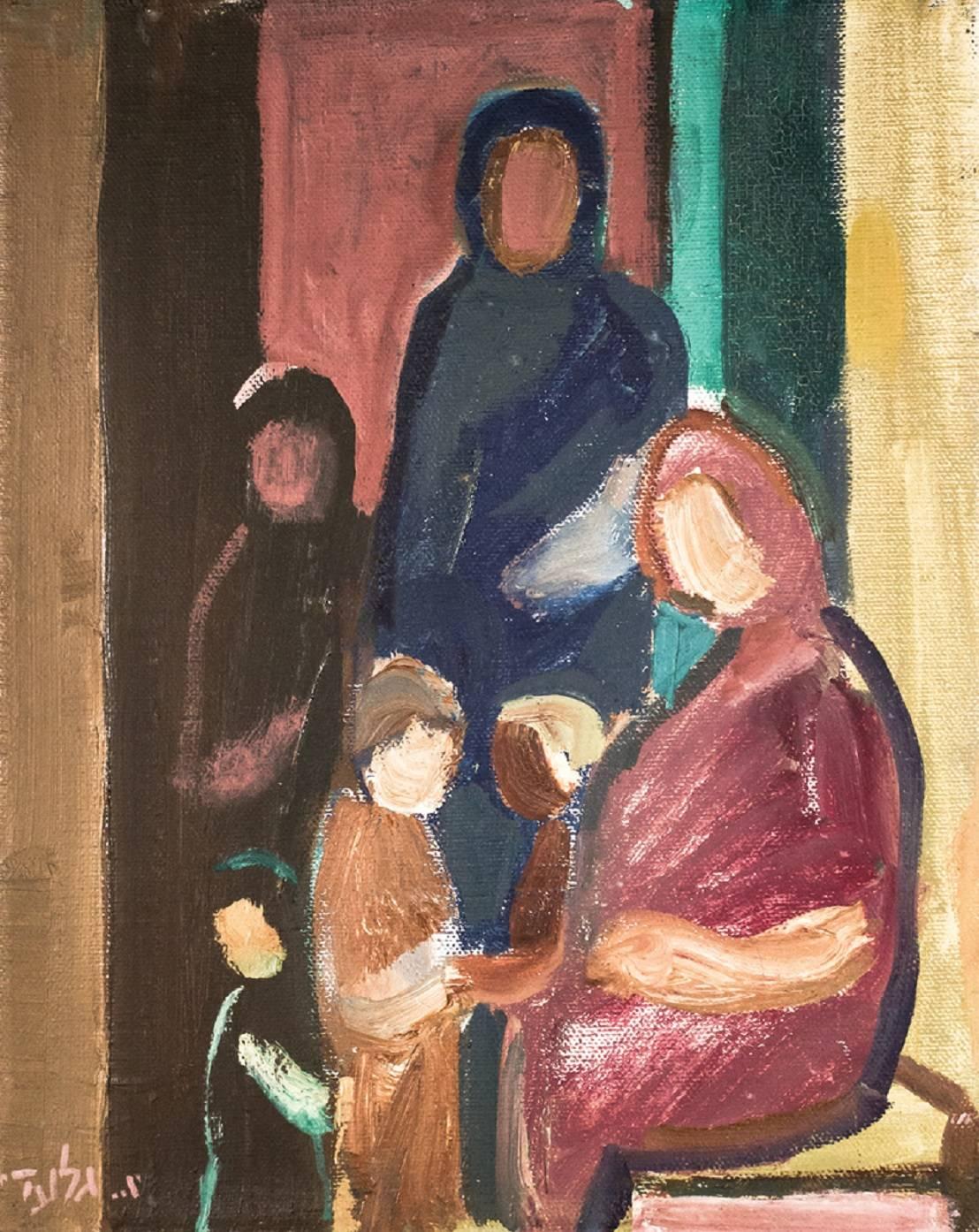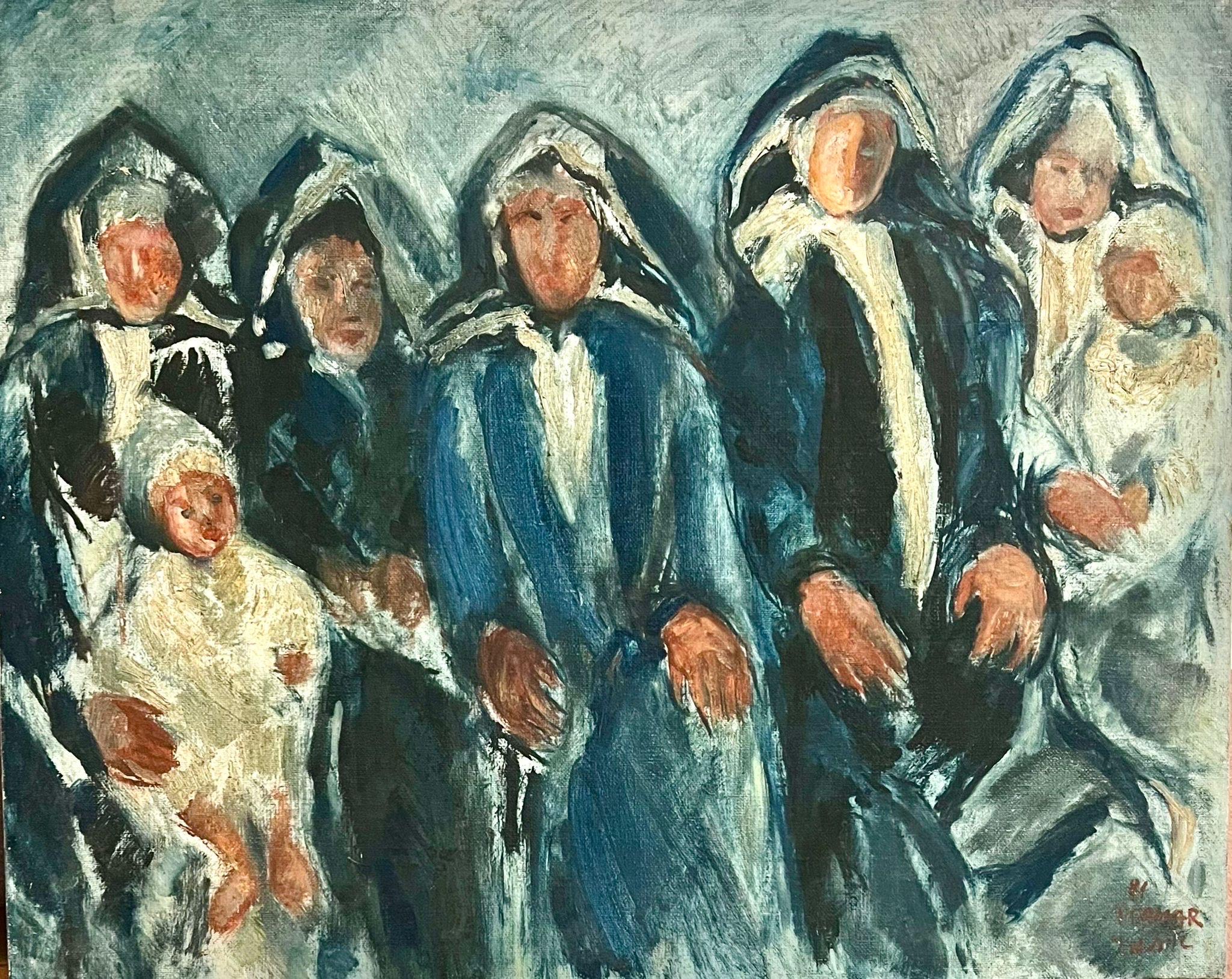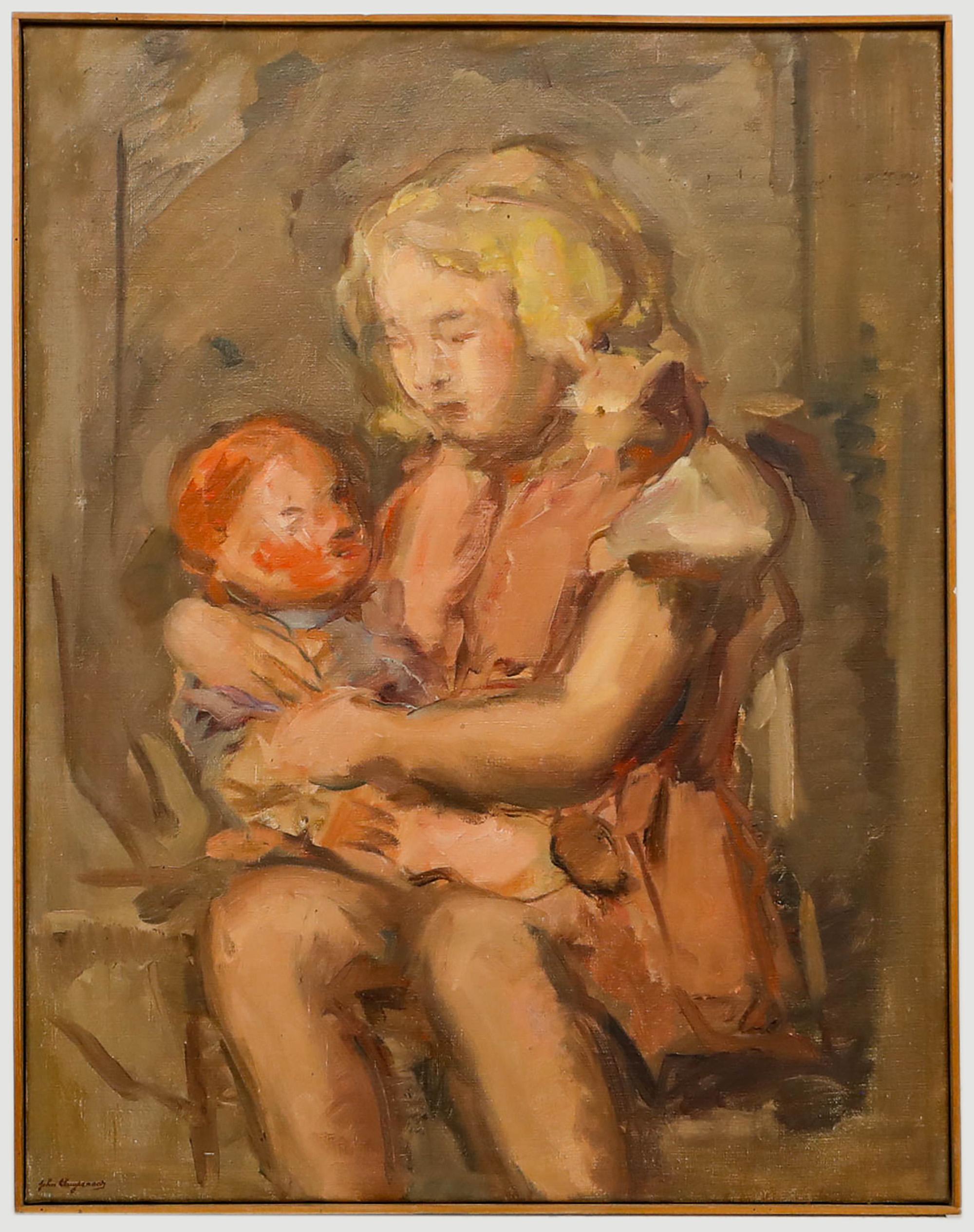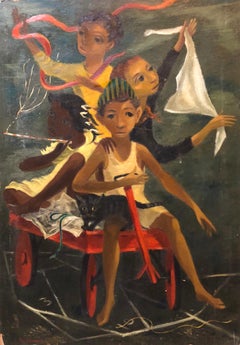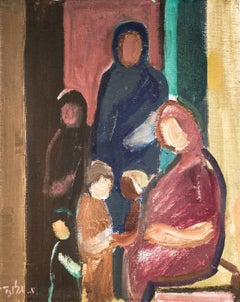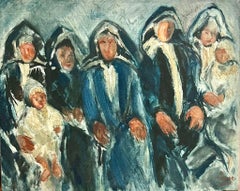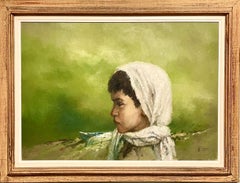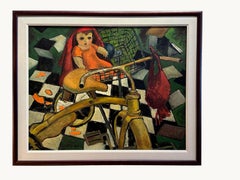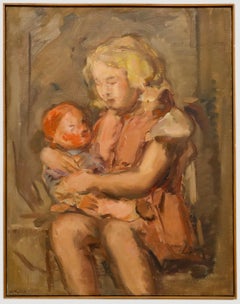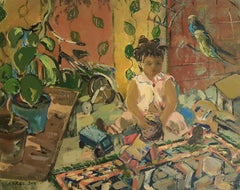Items Similar to Israeli Oil Painting Ruth Schloss Child, Doll, Wagon, Kibbutz Social Realist Art
Want more images or videos?
Request additional images or videos from the seller
1 of 11
Ruth SchlossIsraeli Oil Painting Ruth Schloss Child, Doll, Wagon, Kibbutz Social Realist Artc.1950s
c.1950s
$8,500
£6,454.25
€7,380.92
CA$11,875.73
A$13,208.41
CHF 6,897.02
MX$160,732.26
NOK 88,085.47
SEK 82,608.63
DKK 55,086.62
Shipping
Retrieving quote...The 1stDibs Promise:
Authenticity Guarantee,
Money-Back Guarantee,
24-Hour Cancellation
About the Item
Large magnificent colorful Ruth Schloss oil painting of a child with a wagon with a doll or a baby in a carriage stroller.. Signed in Hebrew
size measures 31x43 with frame , 23x35.25 without the frame. (this is being sold unframed).
Ruth Schloss (22 November 1922 – 2013) was an Israeli painter and illustrator who mainly depicted neglected scenes such as Arabs, transition camps, children and women at eye-level as egalitarian, socialist view via social realism style painting and drawing.
Schloss became Israeli painting’s sensitive, conscious, remembering eye.
Ruth Schloss was born on 22 November 1922, in Nuremberg, Germany, to Ludwig and Dian Schloss, as the second of three daughters of bourgeois assimilationist Jewish family well-integrated into German culture. As the Nazis came into power in 1933, her family immigrated to Israel in 1937, and settled in Kfar Shmaryahu, then an agricultural settlement. Schloss studied at the Department of Schloss graphic design at "Bezalel" from 1938 to 1942 alongside Friedel Stern and Joseph Hirsch. She was a realistic painter who focused on disadvantaged people in the society and social matters as an egalitarian. Her realism was thus an “inevitable realism,” motivated by an inner necessity: the need to observe reality as it is.
Her painting repeatedly addressed the door pulled from its frame, employing drawing’s unique ability to stop time and prolong the image’s persistence in the retina, she repeatedly committed to paper - in a matter-of-fact, non-evasive manner devoid of mystery – man’s tendency to generate chaos, suffering and pain.
Throughout her life, Schloss remained minimalist. Painting about human fate was the main subject of her artworks. Her natural inclination was to describe the darker aspect of human existence.
1930s
The Schloss household was characterized by open, liberal spirit, in keeping with the parents’ progressive views. It deeply influenced Ruth’s mental development, as she learned to tie culture and art with sensitivity towards the weak and underprivileged.
In Jerusalem, she joined a commune of Hashomer Hatzair in which she shaped her socialist views, which she maintained throughout her long career.
1940s
In this period she mainly depicted landscapes of kibbutz and wretched women living hard life, children in huger, older people, refugees. After completing her art studies, Schloss joined a training group at Kibbutz Merhavia in 1942, and after two years moved to Karkur region, the nucleus established Kibutz Lehavot Habashan in the Upper Galilee. Through this time, she fell in love with the surroundings and drew landscapes. They are simple and direct with fresh, lucid lines. These paintings were selected as the main works of her first exhibition in 1949.
In early 1945, Schloss started to draw illustrations in the children’s magazine Mishmar Leyeladim, and designed the logo of Al Hamishmar, the paper’s new name in 1948. In 1948, upon the founding of Mapam (United Workers’ Party), she designed her party’s emblem, which became a well-known icon. She kept working as an illustrator for Mishmar Layeladim until 1949.
"Mor the Monkey" project yielded financial profits and this income was used for a study trip to Paris for two years. She was succesfull as illustrator however, she had inner conflicts of her identity as witnessed painter toward neglected class in Israeli society.
First Exhibition at Mikra-Studio Gallery, 1949
She presented forty drawings on paper in her first solo exhibition, representing a selection of the themes of kibbutz landscape, its lifestyle. Schloss confidently proposed her direction through simplicity without using colors in her drawings.
1950s
Between 1949 and 1951, she studied at the Académie de la Grande Chaumière in Paris.
She began working in oils, with which she continued throughout the 1960s.
The exhibition “Back from Paris” opened in November 1951 at Mikra-Studio Gallery .
In 1951 she married Benjamin Cohen, who served as chairman of the national leadership of Hashomer Hatzair Workers Party in Tel Aviv. He was a theoretician and a man of principle, highly esteemed by its leaders who became a professor of history at Tel Aviv University. In 1953, following the Mordechai Oren affair and the publication of Moshe Sneh 's followers from Kibbutz Artzi, she and her husband left the kibbutz and moved to the agricultural farm, Kfar Shmaryahu, where she lived until her death.
At a certain point in Israeli history, segments of the socialist movement felt that Israel should become part of the Communist bloc, rather than seek the support of the western world. Because the Schloss couple support of Moshe Sneh’s left-wing party, they had to leave the kibbutz.
She loved to depict ordinary women as figurative on her painting without hiding or making up anything. The poet Natan Zach wrote about her works in 1955: “Her motto remains that which has been all these years: life as it is, without bluffing."
Schloss’s “Pietà” (1953) became a universal cry expressing the pain of mothers on either side of the divide. In the late 1950s, she was the mother of two daughters. When she drew her daughters, unlike the universal babies she depicted, naked and with clenched fists, the painting of her children employed babyish sweetness to the full in a quiet, peaceful and heart-stirring filling rather than urgency. She also painted children in the transition camp and Jaffa in the 1950s and 1960s.
1960s-1980s – The period of Studio in Jaffa
Schloss painted at a studio in Jaffa from 1962 till 1983. In this time, she turned her interest to people around her more than kibbutz – the children, mothers, and poor workers, the alleys and houses. She opened the space to the street and its dwellings, built interactions around it, and was nurtured by the presence of the outside in her work.
1960s Schloss familiarized to an Arab woman, Nabava, lived in poor. Schloss returned to painting images of old people later, and she called her painting figurative elderly people in the old age homes “waiting”.
In the late 1960s, Ruth discovered acrylic paint and never turn back to oil painting.
In 1965 Schloss devoted a series “Area 9 (1965)”, dedicated to the demolition of Israeli-Arab houses and the expropriation of the land, and carried a definite socio-political messages. The series was exhibited at Beit Zvi, Ramat Gan, in 1966. She was the only artist who addressed the result of the Six-Day War immediately afterward. In 1968, Schloss and Gansser-Markus presented “Drawing of War” in Zurich gallery. She expressed the war as an ultimate expression of destruction and ruin, regardless of victors and vanquished.
1970s In late 1970s Schloss began printing the selected photograph directly on the canvas, posterior reworking it in acrylic. She decided to print her work at Har-El Printers in Jaffa, and these became the surface of her painting. This technique was mainly adopted in two large series: Anne Frank (1979-1980) and Borders (1982). Through this technique she placed the figure of elder Frank next to that of the famous young Frank, and released it at the exhibition at Bet Ariela Cultural Center, Tel Aviv, in 1981. The series touched upon the Nazi Holocaust.
1980s The Lebanon War raised the question of “The Good Fence” and the effect of the war. She dedicated a large series Boarders, one of the most powerful image linked to the series is the figure of Yemenite woman raising her hand. She was the first to raise the Black Panthers demonstration to the level of a social icon. In the 1980s and again in 2000, the Intifada uprisings also led Schloss to the easel to render a good number of representational and symbolic works that in their way denounced Israel's political and military actions.
1990s – 2000s Ruth Schloss never had an exhibition in a major Israeli museum. Her works were presented in private galleries and small museums. The main museums, the Tel Aviv Museum of Art and the Israel Museum, included her works only in group exhibitions, and only in 1991 was her retrospective exhibited at the Herzliya Museum.
In the 2000s, Schloss’s metaphors turned into animal kingdom and Bedouins in the south. A huge rhinoceros, birds of prey, and other "bad animals," as Cohen Evron, daughter of Ruth, calls them and "I connected this to the Nazis," said Schloss. Schloss' work after she didn't find human expression able to transmit the endless cruelty she saw in Israel's political mentality.
Schloss also continued to follow and collect documentary photographs of destructions of houses from the war, the Intifada, the sequence of her work about ruin from 1949 to 2005, was a cumulative testimony about the painful history of Israel and Palestine.
In 2006, a large retrospective exhibition of her work was presented at the Museum of Art in Ein Harod, curated by Tali Tamir.
Education
1938-41 Bezalel Art Academy, Jerusalem, with Mordecai Ardon
1946 painting course for Kibbutz Artzi artists with Yohanan Simon and Marcel Janco
1949-51 Académie de la Grande Chaumière, Paris
Awards and recognition
1965 Silver Medal, International exhibition in Leipzig, Germany
1977 Artist-in-Residence, The Cité Internationale Universitaire de Paris
Selected solo exhibitions
2004 “Micha Baram, Ruth Schloss: Painting-Photography,” The Art Gallery, Kibbutz Cabri, Israel, Curator: Drora Dekel
2003 “Works on Photographic Paper,” The Artists’ House, Jerusalem, Curator: Irit Levin
2001-2003 “Ruth Schloss: Reacting to Reality, Works 1982-2002,” Habama Center, Ganei Tikva, Israel (curators: Irit Levin, Miri Krymalowski)
2001 “The Last Years,” Givatayim Theater, Israel (curators; Irit Levin, Doron Polak)
2001 “Works, 1991-2001,” Beit Gabriel, Tzemach, Israel
1999 “New Born,” Nophr Art Gallery, Tel Aviv
1998-2004 “Anne Frank in Perspective,” Kunstraum am Hallop, Memmingen, Germanyת Traveling exhibition in France (as part of “Semaine contre le Racisme”)
1997-1999 “In the Footsteps of Caravaggio,” Municipal Gallery, Kfar Saba, Israel
1997 “Past Time,” Nama Gallery and Shai Gallery, Tel Aviv
1993 “People and Years,” Nelly Aman Gallery, Tel Aviv
1992 “Ruth Schloss: Retrospective, 1942-1992,” Herzliya Museum of Art
1989 “Intifada: New Works,” Tiroche Gallery, Tel Aviv
1989 “Borders,” Produzentengalerie, Zurich
1982 “Borders 82,” Herzliya Museum, Israel
1975 Rosenfeld Gallery, Tel Aviv
1974 Mishkan Le’Omanut, Beit Meirov, Holon, Israel
1968 “Drawing of War,” Forum Gallery, Zurich (with photographer Ursula Gransser-Markus)
1966 “Area 9,” Beit Zvi, Ramat Gan, Israel
1957 The Artists’ House, Jerusalem
1956 Traklin Gallery, Haifa
1953 The Artists’ House, Jerusalem
1949 Mikra Studio Gallery, Tel Aviv
Selected group exhibitions:
2015 Israeli Art: The Renewed Collection Galleries, Dr. Julius and Hilde Merzbacher Galleries and the Ayala Zacks Abramov Pavilion for Israeli Art, Israel Museum, Jerusalem
Artists: Reuven Rubin, Ephraim Moses Lilien, Yitzhak Danziger, Lea Nikel, Naftali Bezem, Mordecai Ardon, David Reeb, Ruth Schloss, Yehiel Shemi, Menashe Kadishman, Avigdor Arikha, Moshe Gershuni, Moshe Geva, Tsibi Ginton, David Gitlin, Michael Klapisch, Liliane Klasmer, Gabi Krakauer, Leopold Moshe Kupferman, Sigalit Landau, Moshe Mokady, Ori Reisman, Yehezkel Streichman, Anna Ticho, Sionah Tagger and others.
2006 “Hero – Antihero,” Municipal Gallery, Kfar Saba, Israel, curator: Irit Levin
2005 “Nostalgie de Paris,” Ein Hod Gallery, Israel, curator: Avraham Eilat
2005 “Wounds and Bandaging,” The Art Gallery, Umm el-Fahem, Israel, curator: Eif Gan
2004 “ The Art of Aging,” The Jewish Institute of Religion Museum, Hebrew Union College, New York, curators: Ayana Friedman, Laura Kruger (cat.)
2004 “Drawing. Old & New,” Municipal Gallery at Beit Yad Labanim, Raanana, Israel, curator: Oded Feingersh (cat.),
2004 “Thirty + Three,” Haifa Theater, curator: Smadar Schindler
2004 “You Don’t Look Hungry to Me,” Limbus Gallery, Tel Aviv, curators: Michal Shamir, Orly Wolkowiski
2003 “Ten Women and One Old Man,” Habama Center, Ganei Tikva, Israel, curator: Miri Krymolowski
2003 “Ruins Revisited: The image of the Run in Israel 1803-2003,” Time for Art – Israel Art Center. Tel Aviv, curator: Gideon Ofrat (cat.)
2003 “Wandering Library: Markers IV,” Museo Ebraico di Venezia, Venice, curator: Doron Polak (cat.)
2002 “Imagine: Artists for Coexistence,” The Art Gallery, Umm el-Fahem, Israel; Plonit Gallery, Tel Aviv
2002 “Artist Against the Occupation,” Beit Uri and Rami Nehushtan, Kibbutz Ashdot
2002 Yaakov Meuhad, Israel, curator: Doron Polak
2001 “Against Violence against Women,” Bar-David Museum of Jewish Art and Judaica, Kibbutz Bar’am, Israel, curator: Hanna Barak (cat.)
2001 “Current Affairs,” The Art Museum, Kibbutz Hanita, Israel, curator: Hanna Barak
2001 “Traces: Contemporary Drawing in Israel,” The artists’ House, Jerusalem, curator: Ilan Wizgan, (cat.)
2000 “The Third Color,” The artists’ House, Jerusalem, curator: Ayana Friedman (cat.)
2000 “Women Artists in Palestinian Art,” Bar-David Museum of Jewish Art and Judaica, Kibbutz Bar’am, Israel,
1998 “Women in Israel Art,” Haifa Museum of Art, curator: Ilana Teicher
1998 “Scream Quietly Please,” The 9th Triennial, New Delhi, India, curator: Nella Cassouto
1998 "The East: Orientalism in the Arts in Israeli,” The Israel Museum, Jerusalem, Curator: Yigal Zalmona
1998 “Social Realism in ‘50s, Political Art in the ‘90s,” Haifa Museum of Art, Curator: Gila Ballas
1998 “Homeland Bound: Form the Dream of a National Home to the Dream Home,” The Israel Museum, curator: Tami Schatz
1997 “At Eye Level,” The Artists’ House, Jerusalem, curator: Nella Cassouto
1997 “Remembering Shlomo: Shlomo Weizmann, 1954-1995,” The Art Gallery, Ben Gurion University of Negev, Beer Sheva, Israel, curator: Haim Finkelstein
1992 “Making Peace: In Memory of the Six Day War and the Lebanon War,” exhibitions and meetings, on behalf of the Center for Peace, Givat Haviva, Israel
1991 “The Color Khaki: The Soldier in Israel Art,” Habima Theater, Tel Aviv, curator: Gideon Ofrat
1991 “Animals,” Erek Gallery, Tel Aviv
1989 “To Live with the Dream,” Tel Aviv Museum of Art, curator: Batia Donner
1989 “Portrait,” traveling exhibition, Omanut La’am, Israel, curator: Zvi Tadmor
1988 “A People Builds Its Dream: Israeli History as Reflected in Art,” Herzliya Museum, Israel, curator: Ramy Cohen
1988 “Haifa: Portrait of the City in Painting and Photography,” Haifa Museum of Modern Art, curator: Gabriel Tadmor
1988 “1948: The War of Independence in Israeli Art,” Eretz Israel Museum, Tel Aviv, Curator: Gideon Ofrat
1987 “New Bezalel: 1935-1955,” The Artists’ House, Jerusalem, curator: Gideon Ofrat
1986 “The 49th anniversary of Victory over Nazi Germany,” Municipal Art Gallery, Arad, Israel
1982 “Opinions,” The Artist’ House, Jerusalem
1978 “Artist and Society in Israeli Art 1948-1978,” The Tel Aviv Museum, curator: Sara Breitberg
1977 “Propaganda and Vision: Israeli and Soviet Art, 1930-1955,” The Israel Museum, Jerusalem, curator: Batia Donner
1971 “Israeli Art,” The Tel Aviv Museum, curator: Haim Gamzu
1970 “Exhibition of Drawings from the Museum Collection,” Haifa Museum of Modern Art
1965 “Exhibition of Drawings, 1965,” Haifa Museum of Modern Art
1951 “Back from Paris,” Mikra-Studio Gallery, Tel Aviv
1947 “Artists in the Kibbutz and in the Army,” Mikra-Studio Gallery, Tel Aviv
- Creator:Ruth Schloss (1922 - 2013)
- Creation Year:c.1950s
- Dimensions:Height: 31 in (78.74 cm)Width: 43 in (109.22 cm)
- Medium:
- Movement & Style:
- Period:
- Condition:good. minor wear size measures 31x43 with frame, 23x35.25 without the frame. (frame has wear. this is being sold unframed).
- Gallery Location:Surfside, FL
- Reference Number:1stDibs: LU38214091042
About the Seller
4.9
Platinum Seller
Premium sellers with a 4.7+ rating and 24-hour response times
Established in 1995
1stDibs seller since 2014
1,784 sales on 1stDibs
Typical response time: <1 hour
- ShippingRetrieving quote...Shipping from: Surfside, FL
- Return Policy
Authenticity Guarantee
In the unlikely event there’s an issue with an item’s authenticity, contact us within 1 year for a full refund. DetailsMoney-Back Guarantee
If your item is not as described, is damaged in transit, or does not arrive, contact us within 7 days for a full refund. Details24-Hour Cancellation
You have a 24-hour grace period in which to reconsider your purchase, with no questions asked.Vetted Professional Sellers
Our world-class sellers must adhere to strict standards for service and quality, maintaining the integrity of our listings.Price-Match Guarantee
If you find that a seller listed the same item for a lower price elsewhere, we’ll match it.Trusted Global Delivery
Our best-in-class carrier network provides specialized shipping options worldwide, including custom delivery.More From This Seller
View AllModernist Oil Painting Social Realist Kids and Cat in Red Wagon WPA Style
By Paul Zimmerman
Located in Surfside, FL
Oil on artist's board, 20th century, signed Paul Zimmerman Reminiscent of the Mid Century Social Realist and WPA works of Ben Shahn this captures a group of tenement children of mixe...
Category
Mid-20th Century American Realist Figurative Paintings
Materials
Oil, Board
Family, Mother, Children, Modernist Israeli Oil Painting Aharon Giladi
By Aharon Giladi
Located in Surfside, FL
Aharon Giladi was born in 1907 in Russia. He studied in Leningrad and in 1929 came to Israel, where he was until 1949 a member of a kibbutz in the Jordan Valley.
His dynamic line...
Category
Mid-20th Century Modern Figurative Paintings
Materials
Oil
Rare Jewish Yemenite Family Oil Painting Israeli Judaica Itamar Siani
By Itamar Siani
Located in Surfside, FL
Itamar Siani, Israeli artist, painter, engraver, born 1941, Yemen
His art commemorates the unique cultural heritage and traditions of the Yemenite Jewish community, who returned to the Promised Land on "Eagles' Wings," the code name of the Israeli rescue of Yemenite Jewry in 1949. Among his notable works is a ten-meter long oil painting depicting the immigration of the Yemenite Jews, which he worked on for 30 years.He did a celebrated series titled "The Magic Carpet" etchings depicting stages in the artist’s life including: Liberation, The Magic Carpet, Refugees, New life in Israel, Family, Mount Sinai. published in Jerusalem 1973. The artist was born in Sana’a in Yemen and flown to Israel aged 5 years old as part of operation ‘Magic Carpet’ the mass migration that transported almost the entire Jewish population of this part of the Arabian peninsula to the new State. The etchings continue and develop a long tradition of Yemenite artistry. Yemenite born Israeli painters Avshalom Okashi...
Category
1970s Neo-Expressionist Figurative Paintings
Materials
Canvas, Oil
Large Israeli Expressionist Orientalist Oil Painting Draped Child Kibbutz Art
By William Weintraub
Located in Surfside, FL
William (Sunny) Weintraub, Israeli (Born 1926)
Oil on masonite
William Weintraub (He was also known as Shlomo Weintraub and nicknamed Sonny Weintraub)
Genre: Impressionist
Subject: Portrait
Medium: Oil
Surface: Canvas
Dimensions: framed 24 X 32.5 canvas 19 X 27
In an ever-changing art world that embraces one movement after the next, the timeless art of portraiture can become lost. Portraiture is often associated with the royal paintings of centuries-old French kings, European nobility, and other wealthy individuals from art history's past. However, styles like Social Realism and Dutch genre painting spotlighted...
Category
Mid-20th Century Expressionist Figurative Paintings
Materials
Canvas, Oil, Board
Large Modernist Oil Painting 1940s, Judaica Hasidic Shtetl Wagon Driver WPA Era
By Emanuel Glicenstein Romano
Located in Surfside, FL
Genre: Modern
Subject: Landscape with figure of horse, driver and wagon
Medium: Oil
Surface: wood Board
EMANUEL ROMANO
Rome, Italy, b. 1897, d. 1984
Emanuel Glicen Romano was born in Rome, September 23, 1897.
His father Henryk Glicenstein was a sculptor and was living in Rome with his wife Helena (born Hirszenberg) when Emanuel was born. His father obtained Italian citizenship and adopted the name Enrico. Emanuel was brought up in Italy, Switzerland, Germany, England and Poland.
In 1926 Emanuel Glicenstein Romano and his father sailed for New York. They briefly visited Chicago. Romano's sister, Beatrice, and mother only joined them in New York years later.
Romano changed his name on his arrival to America and some have erroneously speculated that this was to avoid antisemitic discrimination. In truth, as the son of a highly-regarded artist, Romano changed his name to ensure that any success or recognition he would later attain, would be the result of nothing other than his own merit as an artist, and not on account of his father's fame.
In 1936 Romano was worked for the WPA Federal Art Project creating murals. ( there were many jewish artists active with in the WPA period. notably Chaim Gross, Ben Shahn, Isaac and Moses Soyer, Abraham Rattner and many others. During and immediately after World War II, Romano created a series of allegorical works depicting graphic holocaust images that were held closely by the family until after his passing. One of these works is now on permanent display in the Florida Holocaust Museum in St. Petersburg Florida.
Emanuel's father died in 1942 in a car accident before they could realize their shared dream of visiting Israel.
In 1944 Romano, having completed his degree at the Pennsylvania Academy of Fine Arts and the Art Institute of Chicago, began teaching at the City College of New York.
Romano moved to Safed, Israel in 1953 and established an art museum in his father's memory, the Glicenstein Museum.
COLLECTIONS
Indianapolis Museum of Art
Metropolitan Museum of Art
Boston Fine Arts Museum
Fogg Museum
Musée Nacional de France
Recently his work has been added to the Florida Holocaust Museum collection. His notable works include his holocaust themed allegorical paintings as well as portraits of Marianne Moore, his father and William Carlos Williams...
Category
1930s American Modern Figurative Paintings
Materials
Oil, Board
Untitled, Horse and Wagon Pastel Drawing Shtetl Judaica Scene Polish Jewish Life
By Simon Natan Karczmar
Located in Surfside, FL
Simon Karczmar, Polish (1903 - 1982)
Born in Warsaw, Poland, in 1903, Simon Karczmar studied art in Paris, where he lived for twenty years. Although he left France for Israel in 1962, most of his work evokes his experiences in Eastern Europe.
Immigrated to Israel 1962 and joined Artists' Quarter in Safed.
Represented Israel at exhibitions in Mexico, Canada, U.S.A. and Europe.
In this series of images known collectively as Shtetl, Karczmar draws inspiration from his childhood memories of the vacations he spent at his grandfather's house in Lithuania. The word shtetl is Yiddish for little town and refers to the villages with significant Jewish populations that could once be found throughout Eastern Europe.
The nostalgia of Karczmar's renderings contrasts with the darker views of life for Jews revealed in the photographs by Roman Vishniac and drawings of Ephraim Moshe Lilien...
Category
Late 20th Century Modern Figurative Drawings and Watercolors
Materials
Oil Pastel, Mixed Media
You May Also Like
" Tricycle and Doll" Oil on Canvas by Edgar Kiechle
Located in Pasadena, CA
This figurative painting by Edgard Kiechle presents the scenario of a doll who is very surprised to have been abandoned into the basket of her mom's tricycle.
An interesting factor is the pictorial use of angles. The point of view, a little above the stage, probably that of an adult, offers particular perspectives. This approach adds depth to this painting with distinctive compositional appeal.
In contrast to the scene's disorder, a black-and-white tiled floor with a geometric design serves as an antithesis. The careful symmetry of the tiles competing with the surrounding disarray sparks a dialogue about the human need for organization and balance.
In composition, absence is a living element. The exclusion of a physical human figure amplifies the feeling of emptiness, creating a human presence perceived imaginatively.
Edgar O. Kiechle was born in 1911. He was a film illustrator and a painter.
Edgar studied landscape painting with Jean Mannheim and architecture and became an excellent watercolorist. After studying at the Otis Art Institute in Los Angeles, he interned with leading architects and designers. He worked at most major studios, but his career as an illustrator saw him primarily at the Universal Studio Art department.
In 1933, Edgar joined Lwerks as a background artist and worked on many films produced by Animated Picture Corporation through 1935.
In the summer of 1941, Edgar Kiechle...
Category
Mid-20th Century Figurative Paintings
Materials
Oil, Canvas
$850 Sale Price
46% Off
Child with Doll and Buggy, Impressionist Oil Painting by Carlos Irizarry
By Carlos Irizarry
Located in Long Island City, NY
Artist: Carlos Irizarry
Title: Child with Doll and Buggy
Year: circa 1965
Medium: Oil on Canvas, signed l.r.
Size: 30 in. x 24 in. (76.2 cm x 60.96 cm)...
Category
1960s Expressionist Figurative Paintings
Materials
Oil, Canvas
John Cluysenaar (1899-1986) - Mid 20th Century Oil, Young Girl with Doll
Located in Corsham, GB
A fine oil by John Cluysenaar (1899-1986) depicting a young girl holding her doll. Presented in a wooden strip frame. Signed to the lower left. On canvas on stretchers.
Category
20th Century Portrait Paintings
Materials
Oil
Little Girl, Figurative, Original oil Painting, One of a Kind
Located in Granada Hills, CA
Artist: Ara H. Hakobyan
Work: Original Oil Painting, Handmade Artwork, One of a Kind
Medium: Oil on Canvas
Year: 2016
Style: Impressionism
Title: Little Girl
Size: 22" x 28" x 0.8'' ...
Category
2010s Academic Figurative Paintings
Materials
Canvas, Oil
Georges Pacouil (1903-1996) - Framed Mid 20th Century Oil, Dolls in an Armchair
Located in Corsham, GB
Signed to the lower right. Presented in a simple gilt-effect frame. On canvas on stretchers.
Category
20th Century Interior Paintings
Materials
Oil
$320 Sale Price
20% Off
Woman with Child in Crib, Oil Painting by Chaim Goldberg
By Chaïm Goldberg
Located in Long Island City, NY
Artist: Chaim Goldberg, Israeli (1917-2004)
Title: Woman with Child in Crib
Medium: Oil on Canvas, Signed on Bottom Right and Left
Size: 24 x 18 inches...
Category
1960s American Impressionist Figurative Paintings
Materials
Oil
More Ways To Browse
Nazi Art
Communist Art
German Paintings 1930s
Israel Photographs
Refugee Art
Holocaust Art
Mid Century Israeli Art
Naked Women Art
Michael Israel
Painting Of Naked Woman
Alley Painting
Israeli Women
Child Doll
Oil Painting Carriage
Mid Century Mother And Child Art
Mid Century Painting Cats
French Street Scene 1950s
Love Doll
